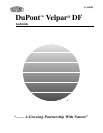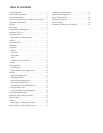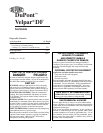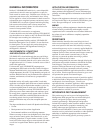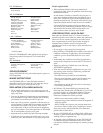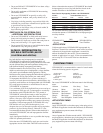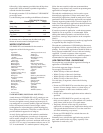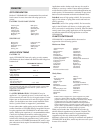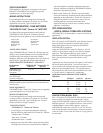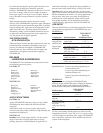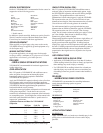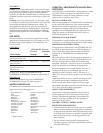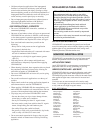
1/3 - 2/3 Lb/Acre
2/3 - 1 1/3 Lb/Acre
1 1/3 - 2 Lb/Acre
* Partial control
DuPont™ VELPAR® DF, when applied in late spring or
after cutting at the following rates, will control these
species:
2/3 - 2 Lb/Acre
SPRAY EQUIPMENT
Apply VELPAR® DF using a fixed boom power sprayer or
aerial equipment.
MIXING INSTRUCTIONS
Add VELPAR® DF to a water-filled tank and mix it
thoroughly. Apply it in at least 20 gal of water per acre by
ground or 5 to 10 gal of water per acre by air.
REPLANTING (FOLLOWING ALFALFA)
• Do not replant treated areas to any crop except corn, root
crops or sugarcane within two years after treatment, as crop
injury may result.
• Corn may be planted 12 months after the last treatment in
areas of moderate to high rainfall (greater than 20 inches),
provided the use rate did not exceed 1 lb per acre.
• Root crops such as potatoes, sugarbeets, radish and carrots
may be planted 12 months after last treatment, provided the
use rate does not exceed 2/3 lb per acre. Sites with use
rates higher than 2/3 lb per acre should not be replanted to
any root crop within 2 years after application of VELPAR®
DF, or unacceptable crop injury may result.
• Sugarcane may be planted any time following treatment.
• In California, do not replant seed alfalfa areas to any crop
within two years after treatment, as crop injury may result.
Flood Irrigated Alfalfa
• When replanting alfalfa to other crops where flood
irrigation was used, follow the guidelines listed above plus
the information below:
In arid climates (10 inches of rainfall or less per year) or
areas where drought conditions have prevailed for one or
more years, a field bioassay should be completed prior to
planting any desired crop. The results of this bioassay may
require the rotation intervals listed above to be extended.
A successful bioassay means growing to maturity a test
strip of the crop(s) intended for production. The test crop(s)
strip should cross the entire field including knolls, low
areas, and areas where any berms were located.
USE PRECAUTIONS - ALFALFA ONLY
Best results are obtained when 1/2–1 inches of rainfall or
sprinkler irrigation occurs within two weeks after application,
when soil is moist at time of application, and when weeds
have not germinated or are less than 2 inches in height or
diameter. Heavy rainfall or excessive irrigation after
application may result in crop injury or poor performance of
the herbicide.
• Do not apply to snow-covered or frozen ground.
• Since the effect of VELPAR® DF on alfalfa varies with soil
conditions, uniformity of application, and environmental
conditions, growers should limit their first use to small
areas.
• If abnormally dry conditions exist following application,
restrict the first irrigation to no more than 1/2 acre inch of
water.
•Temporary yellowing of alfalfa may occur following
VELPAR® DF applications.
•Treat only stands of alfalfa established for one year or for
one growing season (except in California), provided the
following conditions are met:
–The alfalfa root system must be well established.
–The crop must be healthy, vigorous and not under stress
from adverse weather conditions, insect or disease
damage.
–The alfalfa crop must be free of excessive winter injury
from freezing and thawing.
• In California, fall planted alfalfa may be treated in the
following winter months with VELPAR DF at 1/3 to 2/3 lb
per acre to suppress or control Black Mustard, Common
groundsel, London rocket, Shepard’s-purse, Common
chickweed, Fiddleneck or Filaree, provided:
- alfalfa root growth exceeds 6 inches in length
- vegetative top growth of alfalfa has lateral development of
secondary growth
- alfalfa is healthy and vigorous, not growing under stress
from insect, disease, winter injury or other types of stress.
Injury may result to alfalfa plants that fail to meet these
growth criterion listed above.
• Do not use VELPAR® DF on seedling alfalfa, alfalfa-grass
mixtures, or other mixed stands as injury may result to the
seedling alfalfa or companion crop.
• At elevations above 4,000 feet, do not use VELPAR® DF
on alfalfa that has been established with a cover or nurse
crop until the alfalfa has gone through two summer growing
seasons.
Common lambsquarters
Crabgrass
Fleabane
Foxtail (Setaria spp.)
Jimsonweed
Redroot pigweed
Common dandelion*
(i.e. Canada bluegrass)
False dandelion
Foxtail (Setaria spp)*
Mexican tea*
White cockle*
Perennial bluegrass*
(spring only)
Prickly lettuce*
Ryegrass, annual
Quackgrass*
Seedling alfalfa*
Annual bluegrass
Blue mustard
Cheatgrass (downy brome)
Common chickweed
Common groundsel
Dogfennel (mayweed)
English catchfly
Fiddleneck (tarweed)
Field pennycress
Filaree
Flixweed
Jim Hill mustard
London rocket
Miners lettuce
Salsify
Seedling orchardgrass
Shepherd’s-purse
Spurry
Tansy-mustard
Wild radish
Yellow rocket
Tansy-mustard
4



